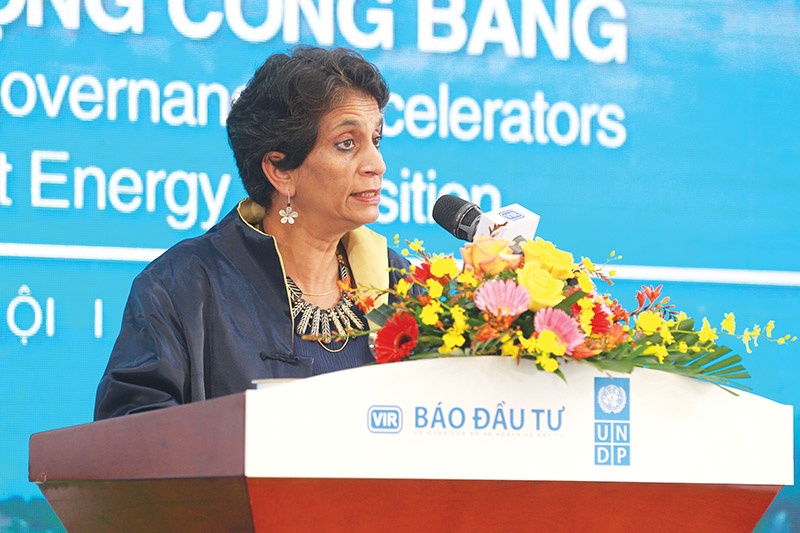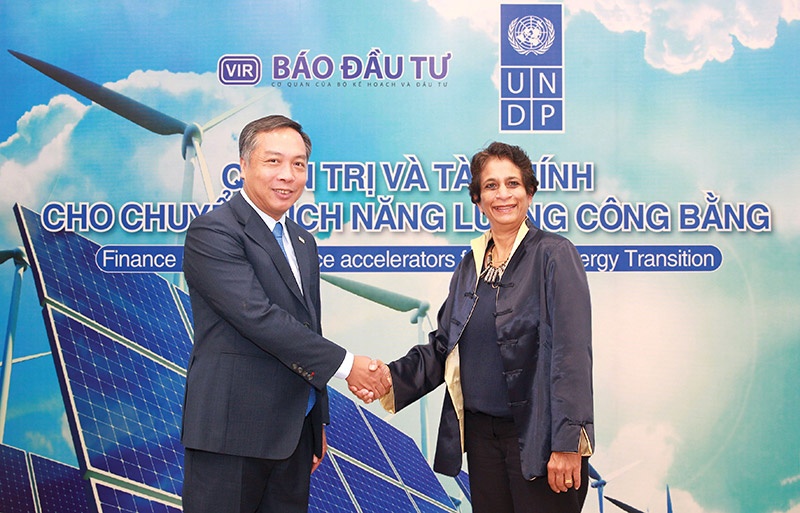The keys to financing a just energy future
 |
| Kanni Wignaraja, assistant secretary-general at the UN and regional director for Asia-Pacific at the United Nations Development Programme |
In February, the Vietnamese government and the United Nations Development Programme organised a major international conference in Hanoi on prospects for a green and inclusive rebound from the pandemic. Speakers at the event drew lessons from the pandemic about our collective efforts to contain and minimise the negative impact of shocks, and what it would take to shift to a green economic impulse for growth and to address climate change.
The unifying thread that ran through every session of the conference was the imperative of maintaining a laser focus on equity and inclusion in the design and implementation of policies responding to these deeply interrelated crises. The idea of a just energy transition has been circulating in academic and advocacy circles since the 1980s but was first used formally in a multilateral global document in the preamble to the 2015 Paris Agreement. It refers to the replacement of fossil fuels with renewable energy in a manner that contributes to, rather than retreats from, the achievement of social and economic equality.
The ambition is that a just energy transition will reduce greenhouse gas emissions while achieving Sustainable Development Goal (SDG) 7, which also calls for access to affordable, reliable, sustainable, and modern sources as well as a supply of energy for all.
The issue of energy security is now also central to the debate. With recent global crises that have disrupted the existing energy demand and supply equations, countries wish to rapidly become more secure. Energy is also at the heart of so much more. For example, limited access to electricity is an obstacle to achieving the other SDGs, including ending poverty and hunger, and universal access to health services, jobs, technology, and education.
We now have evidence that the transition to renewable energy will create more jobs than it will replace, although it will create gaps and winners and losers in the labour market in the short term. Countries that manage the transition well will plan ahead for this, knowing that the new jobs will not necessarily be created where the old ones are lost, or where they are most needed. So, education, skills upgrading and standing social protection are key components of a just energy transition – and new jobs in the new tech and manufacturing sectors must specifically target those otherwise left behind.
Significant costs
There is also an international dimension to a just energy transition. Climate extremes in the form of floods, droughts, and sea level rise hit poor and marginalised communities hardest. Many of these communities are in developing countries, in which carbon per capita carbon emissions are many times lower than in the industrialised world.
While new development models are being sought where one can achieve sustainable development while decarbonising, it is also important that wealthy nations support developing countries, particularly least developed countries and small developing island states. This would make this transition faster without sacrificing overall human and planetary wellbeing.
The transition to renewable energy carries a cost. In its Country Climate Development Report, the World Bank recently cited $368 billion dollars from now until 2040, or seven per cent of GDP annually. This is a significant investment – but is it really a question of how much money, or is it something else?
Although wind and solar have lower operating costs, they are more capital intensive in their startup than traditional coal and gas-fired power plants. Electricity grids will need upgrading to move power from surplus to deficit regions and to balance peaks and troughs in demand. Production methods in industry and agriculture will need to be modernised to make the shifts.
Mass transit systems will be needed to invest in clean energy sources, e-vehicles, rails, and charging stations, in fact, the whole ecosystem, to support new energy sources. And people now used to their petrol and diesel-powered vehicles will have to adjust. This behavioural change is needed and social dynamics cannot be underestimated. So I would posit that the volume of capital exists and that the real question around financing a just energy transition may have to do with how to get that money to move to these investment needs.
In development, finance, profitability, and predictability are the key factors that move capital. So we need to test the hypothesis that if the right policies and incentives are in place, then both the state sector and businesses need to generate profitable, bankable projects that become high-value investment propositions.
Vietnam’s solar power boom illustrates this. It began in 2018 and continued through to last year, and showed that given the right policy mix, financing was forthcoming. Fixed feed-in tariffs (FiTs), set at a relatively high level, ensured that approved solar power projects would generate revenues on the scale required to cover the cost of capital.
While fixed FiTs worked in this short-term case, they are an expensive solution given the rapid pace of technological change and the falling cost of renewable power generation. New technologies will continue to drive down the price. So setting high FiTs soon reduces the competitive pressure on lower prices, and makes coal and gas appear more competitive than they actually are.
 |
| VIR editor-in-chief Le Trong Minh and Kanni Wignaraja made keynote remarks last week |
New and upgraded systems
A few lessons leant, from Vietnam and elsewhere, in countries that have remained committed to a just energy transition, even when buffeted by current global economic and energy market trends. And from these lessons, there are at least six proposals to consider.
Starting with the most obvious, this cannot be left to markets alone. Governments need to play the role of early investor and risk absorber in essential physical infrastructure, and as the guardian of an attractive regulatory environment for profitable investments in renewables.
The second is financing a smart national grid. In most developing countries, including here, the current national electricity grid cannot accommodate the extra supply. Investment in the electricity grid is a precondition for sustained investment in renewable energy. Smart grid technology that uses AI to purchase power at the lowest price and balance energy supply and demand across locations and, over time, will eventually replace fixed FiTs.
Next, investment in an upgraded grid and for contexts that require off-grid solutions can come from the usual sources, including taxation and domestic bond sales. It can also come from carbon taxes. When done well, this not only generates revenues for public investment but also encourages businesses and households to use energy more efficiently.
An emissions trade system that caps the total amount of emissions but allows low-emission industries to sell their allowance to more carbon-intensive industries is the best solution but entails high monitoring and enforcement costs. Working towards such a transparent carbon market is an achievable goal for Vietnam.
In the meantime, a simple tax on fossil fuels is easy to administer and offers a good interim alternative. Taxing petrol is politically unpopular, but it is a progressive tax that falls more on the wealthy. And all this calls for reducing and removal of fossil fuel subsidies that have long been a high cost to public budgets. Specific fuel subsidy support to the poorest households can be targeted through employers or other means.
Green bonds are another option for public investment projects, particularly those that require imports of capital goods and technology. If investor interest in green bonds is sufficiently high, they could provide a cost-effective alternative to other sources of borrowing.
Meanwhile, many countries have created specialised banks to expand the supply of long-term financing for large energy projects. They provide guarantees for commercial bank loans, organise structured finance for slow-gestating projects, and take an equity stake in projects that deliver important social benefits. The involvement of private investors and foreign institutional partners in the governance of these institutions ensures that they operate on a commercial basis and do not rely on government funding.
The goal of Vietnam to achieve net-zero emissions by 2050 and phase out coal power by the 2040s marks a turning point in the country’s sustainable development path. Clearly, protecting vulnerable communities from the effects of climate change and preparing the workforce for the jobs of the future remain top priorities if Vietnam is to achieve these combined goals.
It is also clear that public investment, regulatory reform, and the development of new domestic financial instruments and institutions will transform the financial and governance context for the energy transition. Vietnam cannot do this alone. Vietnam’s energy partnership with the G7 countries is a potential source of support for some of these proposals. International partners must recognise their commitment to share technology, expertise, and financial support to achieve this transition.
We stand ready to support the government and people of Vietnam in this historic transition from fossil fuels to renewable energy, which will be a demonstration to the world that human and planetary well-being can be advanced, while decarbonising and leaving no-one behind.
What the stars mean:
★ Poor ★ ★ Promising ★★★ Good ★★★★ Very good ★★★★★ Exceptional
Related Contents
Latest News
More News
- Businesses ramp up production as year-end orders surge (December 30, 2025 | 10:05)
- Vietjet chairwoman awarded Labour Hero title (December 29, 2025 | 13:06)
- How to unlock ESG value through green innovation (December 29, 2025 | 10:03)
- AI reshapes media and advertising industry (December 29, 2025 | 08:33)
- FPT and GELEX sign deal to develop blockchain tech for global markets (December 29, 2025 | 08:29)
- Vietnam’s GDP forecast to grow by 9 per cent in 2026 (December 29, 2025 | 08:29)
- Women entrepreneurs are key to Vietnam’s economic growth (December 29, 2025 | 08:00)
- Vietnam's top 500 value-creating enterprises announced (December 27, 2025 | 08:00)
- The PAN Group shaping a better future with ESG strategy (December 26, 2025 | 09:00)
- Masan Consumer officially lists on HSX, marking the next phase of value creation (December 25, 2025 | 13:20)

 Tag:
Tag:





















 Mobile Version
Mobile Version